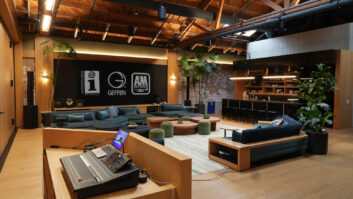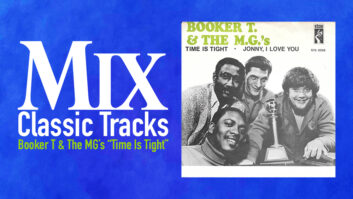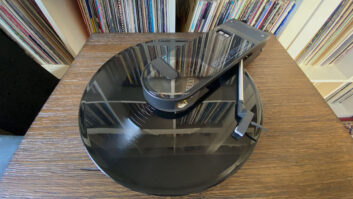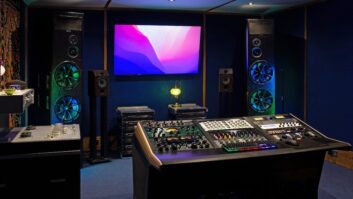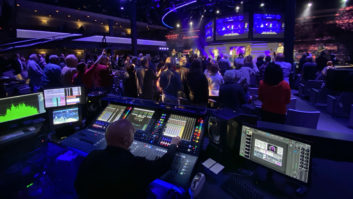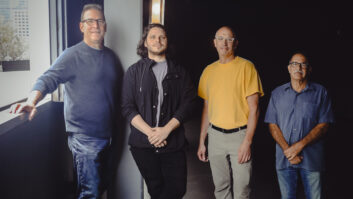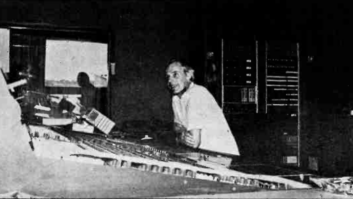Nearly 50 new large-diaphragm condenser mics have been released during the past 18 months. One microphone can re-create any polar pattern or mic angle, another has seven interchangeable capsule heads, and a few can even be remotely controlled. All offer features, value and goodies worth checking out.
It seems the tube mic storm predicted in last year’s Mix (“The New Tube Microphones,” August ’98) has arrived, though the balance between transistorized and tube still leans toward solid-state. If you look back to eight months before that issue, to the ’98 winter NAMM show, 21 tube and 27 solid-state large-diaphragm (1-inch or larger) condenser mics have been released. Described here is the latest crop of tube and solid-state offerings. Please note that companies that are not currently making large-diaphragm condensers (such as Countryman, Crown, Earthworks, Sennheiser and Schoeps) are not included. Neither are those that specialize in ribbon mics (such as Royer, Coles and Audio Engineering Associates). Nevertheless, there are still cabinets of new mics to look over.
AKG released the C4000B ($848), an electret dual large-diaphragm transducer mic with selectable omni, cardioid and hypercardioid polar patterns, and bass-cut filter switches. The solid-state C4000B uses a transistorized impedance converter/preamp and includes a spider shock-mount, and an integrated wind and pop screen.
The first family of FET and tube mics developed for Alesis’ new GT Electronics division includes the AM51 ($549), AM52 ($699), AM61 ($999) and AM62 ($1,299). Nifty hard-shell cases and hard-mounts are standard equipment for each, and the tube AM61 and AM62 add an external power supply, shock-mount and 6-pin cable. The AM52 offers cardioid, omni and figure-8 pattern selection. The AM51 is fixed cardioid, and both 50 Series condensers are Class A FET mics with gold-evaporated mylar diaphragms and switchable -10dB pad and 80Hz low-frequency roll-off. The 60 Series mics use military-spec Groove Tubes vacuum tubes and are electronically identical save for the AM62’s ability to switch between omni, cardioid, figure-8 and supercardioid polar patterns.
Alesis recently expanded its GT Electronics line with the AM11, a large-diaphragm condenser model based on Class-A FET electronics. The AM11 features a 6-micron gold-evaporated 1-inch diaphragm, -10dB pad and bass rolloff switch. The mic retails at $399 and ships this fall.
Audio-Technica released the tube-based AT4060 ($1,695), a dual large-diaphragm condenser mic. The fixed-cardioid 4060 offers an impressive 150dB maximum input SPL (1 kHz @ 1% THD) and includes an external power supply, 32-foot cable, protective mic case, shock-mount and switchable 120V/230V power for globe-hopping recordists.
Audio-Technica unveiled the AT4047/SV at summer Namm. Designed to simulate the characteristic sound of vintage FET microphones, the AT4047/SV is a single-pattern (cardioid) design with a large-diameter, gold-sputtered diaphragm condenser capsule, priced at an affordable $695.
Arriving on the large-diaphragm condenser mic scene the past year was Audio DeutchKraft/ADK. The Oregon-based company released four affordable cardioid pressure-gradient mics, each with 1-inch gold-sputtered diaphragms, discrete FET electronics, PC board upgrade kit options, a shock-mount and a flight case. The base model A51 is $495, the A51s ($595) adds low-frequency roll-off and -10dB pad controls, and it is available in shiny Limited Edition Silver for $625. The A51sd ($770) adds switchable polar patterns.
Audix introduced its CX101 ($499) and CX111 ($599) large-capsule condenser mics last year. Both are cardioid and come with a shock-mount stand adapter and aluminum carrying case. Both also feature a 1-inch gold-vapor diaphragm and black satin finish. The CX111 is the same mic equipped with a -10dB pad and low-frequency roll-off switch.
B.L.U.E. Audio, a.k.a. Baltic Latvian Universal Electronics, released two new mics and a crate full of hand-built capsules for the company’s Bottle mic (released in 1997). The Blueberry ($1,295) and appropriately named Mouse ($2,295) are fixed-cardioid Class-A discrete condenser mics that sport 22 to 22k Hz frequency response; a custom wooden case; and optional pop filter, shock-mount and high-definition mic cable. Bottle owners now have seven pattern capsules to choose from, ranging from single back-plate cardioid to perspex sphere pressure omnidirectional. All capsules retail for $950, except for the $1,500 perspex omni.
Benson Audio Labs’ LDC2000 ($399) is an externally polarized large-diaphragm cardioid condenser mic with internal shock isolation suspension system, built-in 80Hz low-cut switch and a gold-plated 3-pin XLR connector. The LCD2000’s gold-plated diaphragms are aged for added uniformity, and a stand-mounted shock isolation system works in tandem with the internal one to negate hand, boom and stage bumps.
New from Beyerdynamic is the MCE 90 large-diaphragm electret condenser mic, operating at 12 to 48VDC phantom power and featuring high SPL handling, a transformerless design, linear frequency response and low self-noise. Priced at $649, the MCE 90 has a switchable attenuation pad and low-cut filter.
BPM Studiotechnik’s CR-95 ($1,099), TB95 ($1,699), CR10 ($549) and CR-73II ($899) are four hand-crafted German condenser mics that were only available in the States by special order until Peninsula Marketing & Import (www.pmiaudio.com) began exclusive distribution eight months ago. The CR-95 is a dual-gold-diaphragm, transformerless mic with selectable cardioid, omni and true figure-8 patterns, along with bass and pad cuts. The TB95 is a double-triode tube mic with the same polar patterns and cut switches. The CR-73II is a new dual-diaphragm mic with pad/bass-cut switches and selectable omni and cardioid polar patterns, and the CR10 is an affordable cardioid-only mic with the same 1-inch gold-micron diaphragm and accessories as the rest of the BPM line.
The Vx2 Dual Valve Condenser Microphone from CAD is a true dual tube design with separate tube head amp and tube output circuits, three pickup patterns (cardioid, figure-8 and omni) and a large 1.25-inch-diameter capsule with 3-micron-thick, gold-sputtered diaphragms. Other features include dual nickel-core humbucking output transformers, 8/16dB noncapacitive pads, 80Hz highpass filter and optional detachable capsule/screen assemblies offering alternate frequency responses and sounds. An onboard 24-bit A/D converter option (with sampling rates up to 96 kHz) is also optional. The Vx2 is priced at $2,249, including ZM-2 shock-mount.
CAD’s VSM1 single-tube, true condenser microphone is designed to provide the character of CAD’s top-of-the-line Vx2 mic, but in a lower price, single-pattern cardioid version. The VSM1 combines valve and Equitek servo condenser technology with large-diameter (1.10-inch), 3-micron-thick, gold-sputtered diaphragms. Other features include low-noise performance (15 dBa) and maximum SPL handling of 149 dB (<0.5% THD) with the -16dB pad switched in. Retail is $1,299, including power supply.
The CAD E350 Servo Condenser Multi Pattern Microphone offers a choice of cardioid, figure-8 or omni polar response, and features a -20dB noncapacitive pad, 80Hz bass roll-off filter and ZM-1G shock-mount. Its internal NiMH battery supported power supply allows remote operation even when 48VDC phantom power is unavailable. Retail is $899.
The first two products in CAD’s new end-address series of microphones, the ME F3 ($799) and ME V4 ($1,099) are designed for broadcast, live performance and recording applications. Both of these cardioid mics use an Optema Series capsule with 1.10-inch, gold-sputtered diaphragm. The solid-state ME F3 is based around CAD’s “Equitek” servoed head amplifier; the tube ME V4 integrates the same capsule and Equitek servo condenser technologies found in the ME F3, combined with CAD’s Vx2 valve technology, offering rich harmonic overtones associated with classic tube mics.
Building on the success of its AL-1 system, Curtis Technology is now offering the AL-2, a stereo tube system comprising two individual large-diaphragm (22mm capsule) mics with an elongated cardioid pattern that’s designed to provide maximum isolation in live or studio applications. The rackmount power supply connects to the mics via Mogami cable; the entire matched-pair system is priced at $2,995.
The hand-built Dirk Brauner VM1 Tube ($3,495) features continuously variable pattern controls on the power supply, 20 to 24k Hz response and a sophisticated 360Degrees phase-shiftless windscreen. The Valvet ($2,695) uses the same capsule and sounds just like a VM1 but replaces point-to-point internal wiring with a circuit board and opts for a transformer instead of the VM1’s custom twin core design. The VMS1 Stereo ($7,495) is a stereo version of the VM1 with rotatable matched capsule sets and a custom case that houses both mic and power unit.
TGI North America now distributes DPA Microphones, the mics formerly known as Bruel & Kjaer. Realigned last year as DPA, the company has released its Type 3541 Vocalist and Instrument ($6,000) microphone kit, a slender, large-diaphragm, omnidirectional mic with interchangeable capsules and preamps based on B&K’s popular Type 4040 Hybrid mic system. A wide range of add-on options include two types of preamp modules, a mic capsule with an A-weighted self-noise level of only 7 dB, and others previously available for the Series 4000 B&Ks.
Lawson sells its mics factory-direct with a no-risk, ten-day money-back trial period. Included are the new L47MP ($1,995) and L47C ($1,695). The MP is a vacuum-tube, multipattern condenser that can be selected to virtually any polar pattern, and everything in between, and is available loaded with 12AY7 or EF86 tubes, a Jensen transformer, internal shock-mounted, gold-deposited capsule, -12dB pad switch, and gold or satin nickel finish. The L47C is a large-diaphragm, fixed-cardioid tube mic that sports the same internal shock-mounting, transformer and pad, but offers either 6072 or 6267 vacuum tubes.
Marshall Electronics offers the MXL2001 ($199), an economical studio condenser mic with a 1-inch, gold-sputtered diaphragm in a solid machined-brass enclosure. The MXL 2003 ($399) is a new mic with a slightly larger diaphragm, extended low-frequency response, three-position low-cut 0dB/-10dB pad switch, and a shock-mount.
Microtech Gefell is another German mic group that has released new products the past 18 months. The M930 and M940 ($795 each) are tuned to provide a slight presence boost from 7 to 11 kHz and feature internally suspended capsule and electronics to reduce mechanical and external noise. The M930 offers up a fixed cardioid polar pattern, the M940 is a supercardioid version, and each is available in nickel matte or dark bronze housing finishes.
Sweden’s Milab has joined the digital mic movement started by Beyerdynamic three years ago. The Milab DM-1001 is a studio condenser with integral 24-bit/48kHz converters, each fed from its dual large, rectangular diaphragms. A rackmount controller provides AES and S/PDIF digital outputs and manual selection of polar patterns. The controller also has an interface to an external PC for computer-based DSP control (and storage) of digital filtering and customized, user-defined polar patterns, created using direct control of the capsule’s front and back signals via DSP.
New from Neumann is the M147 Tube ($1,995), the next in the company’s long line of vacuum tube condenser mics. Sporting a fixed cardioid pattern, pressure gradient transducer and transformerless output, this mic’s K47 dual diaphragm capsule is the same found in the legendary U47 and M49 microphones, and the 147’s circuitry is the same that is used in Neumann’s top-of-the-line M149 tube mic.
Pearl, a Swedish company that has been making microphones since World War II (distributed domestically by Independent Audio), released its CC22 ($1,028) cardioid condenser model within the past year-and-a-half. A rectangular dual membrane capsule is used to enhance low-frequency response, and the 22’s transformerless preamp circuit promises quiet operation.
The RODE family of large-diaphragm condenser mics are distributed by Event Electronics. The tubular RODE NTV ($1,199) is the latest addition to the lineup and features a capsule-suspended diaphragm sans center wire for improved low-frequency response, twin triode tube, custom Jensen output transformer and 1.15-inch gold-sputtered diaphragm. Also served up are gold-plated jacks and connectors, a power supply, 30-foot multicore copper cable, birdcage shock-mount and aluminum flight case.
Shure has graced microphone buyers’ guides for decades, and the company’s KSM32/SL ($1,029) and KSM32/CG ($959) make this year no exception. Both are side-address, transformerless cardioid mics with low-mass Mylar diaphragms, bass roll-off, and -15dB pad switches and internal shock-mount systems. The SL comes in a champagne finish and velveteen pouch, and sports both swivel and shock-mount connectors. The CG is the same mic wrapped in charcoal gray and a padded zipper carry bag.
Soundelux has been extremely busy since January 1998, releasing five new tube microphones. The U95s ($3,599) and U95 ($1,995) both offer variable omni, cardioid, figure-8 patterns and six intermediate pattern steps between them. Also included are power supplies and shock-mounts, and each comes in a crafted wood box. The new U97 ($599) is a transformerless FET mic with the same pattern selections and box, the U195 FET ($995) is a cardioid FET, and the PTM ($1,199) is a cardioid tube mic with switchable 115/220V operation, shielded AC cable, mic clip and the same lacquered wood box.
SoundField released three adjustable multicapsule condenser microphones that look as much at home in a studio as in a Jules Verne novel. The SPS 422 ($3,995) is a four-way mic system co-developed with Britain’s National Research Development Corporation to explore recording applications. It consists of a four-capsule array (front left/right and rear left/right) connected to a single-rackspace controller. The rack controls all mic settings and allows engineers to re-create anything from a focused mono cardioid to full four-way stereo spread from the control room. According to SoundField, the MK 5 ($7,995) is the only truly coincident stereo microphone in the world. It employs a rack unit to steer and move the microphone capsules electronically to achieve polar pattern and angles, and to provide control over azimuth, elevation and dominance. Azimuth controls mic rotation and placement 360Degrees, elevation changes vertical capsule positioning up or down 45Degrees, and dominance models the mic closer or farther from the source. Virtually any mic configuration and any polar pattern are duplicatable with the MK 5.
Stedman’s C15 ($599) large-diaphragm cardioid condenser mic uses a beefed-up and buffered output circuit to ensure better output regardless of preamp and/or mixer available. A gold-sputtered Mylar diaphragm is used, and the optional metal Proscreen pop filters are patented designs that are washable and direct wind from “pops” downward away from mics.
